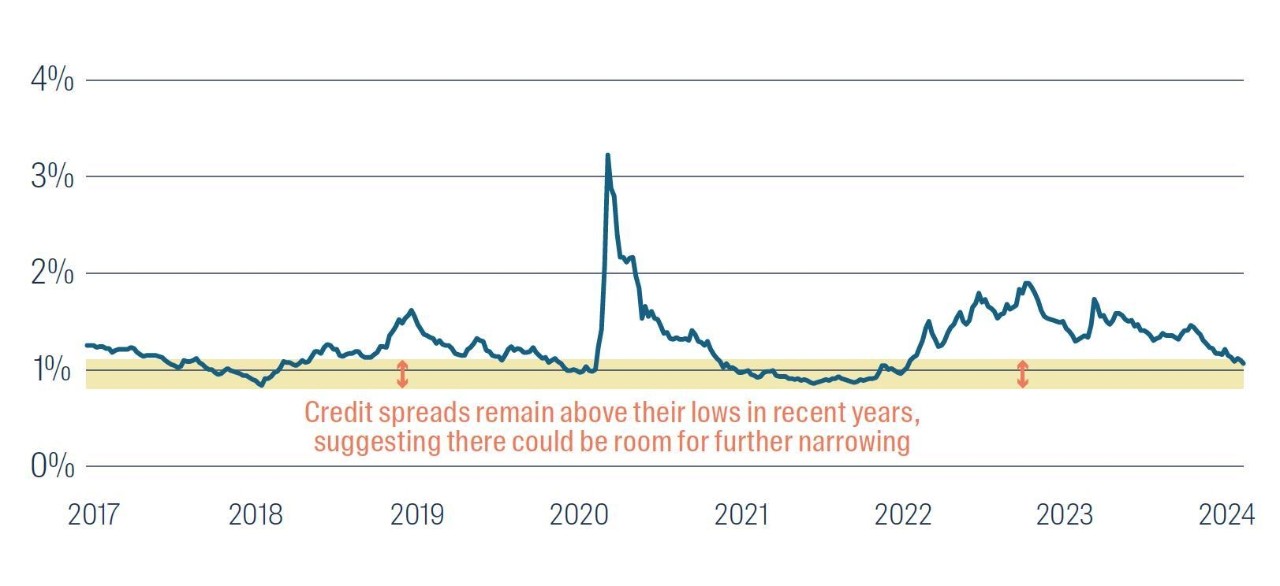3 reasons this asset class should be on everyone's radar in 2024
1. Appealing prospective returns from the asset class
The uptrend in bond yields globally in 2022 and 2023 has pushed the prospective yield of credit portfolios close to the highest level in around 15 years(1). More importantly, we expect global credit yields to remain elevated throughout this year, which could prove enticing for income-oriented investors in particular.
Figure 1: Bloomberg Global Aggregate Corporate Index yield

Source: Bloomberg. Data shown 1 January 2004 to 14 February 2024
Separately, despite a steady and persistent narrowing in 2023, there is still scope for credit spreads to tighten further from current levels in our view. This would further enhance returns, adding to the return expectations from the asset class.
Figure 2: Bloomberg Global Aggregate Corporate Index – spread over and above 10-year Treasury yields

Source: Bloomberg. Data shown 1 January 2017 to 14 February 2024
Following increases in interest rates globally over the past year or two, a meaningful proportion of corporate bonds are trading well below their par value. At the end of January 2024, around a quarter of all bonds in the Bloomberg Global Aggregate Corporate Index were trading below 90 cents on the dollar(2).
Securities trading well below their par value tend to have relatively narrow credit spread premiums, due to the perceived negligible credit risk of buying a bond at, say $80, but being entitled to the repayment of the bond’s face value of $100 at maturity. There is scope for meaningful capital appreciation from these bonds as they approach maturity and the prices pull towards par. It is also worth considering, however, that the narrow credit spreads on these bonds is likely pulling the overall market average down. Excluding this cohort would therefore suggest the average spread of other index constituents is somewhat higher, arguably providing even more scope for spread tightening.
2. Credit fundamentals remain supportive, in our view
Looking ahead, the latest forecasts from the International Monetary Fund(3) suggest major economies will remain quite resilient this year, despite headwinds from higher interest rates. Any recessions in individual countries are expected to be short and shallow in nature, such as those recently reported in Japan and the UK for the second half of 2023. Credit investors should be reassured by these latest projections, as there is typically quite a strong correlation between economic activity levels and company profitability.
In fact, listed companies worldwide are currently in the process of announcing their financial results for the December quarter and for the 2023 calendar year as a whole. Releases to date suggest most firms remain in healthy shape financially, particularly in the US.
After peaking just below the long-term trend in 2023, we do not anticipate a meaningful pickup in default rates among corporate issuers in the foreseeable future. Remember, as long as companies can service their debt repayment obligations and do not default, the regular income stream provided by their coupon payments will continue to support returns from global credit portfolios.
3. An uptick in activity among institutional investors
Institutional investors seem to be sitting up and taking notice of the higher prospective returns on offer and we have seen increased interest from institutional investors in the US, Europe and elsewhere. This uptick in enquiries suggests sophisticated investors – including pension funds and sovereign wealth funds – are considering increasing their allocations to corporate credit. This could be a useful tailwind, as sizeable inflows into the asset class typically help support valuations.
In the early part of 2024, we have also seen a good level of new corporate bond issuance as companies have looked to tap into the healthy demand and raise fresh capital. More than US$160 billion of new investment grade corporate bonds were issued in the US alone in January alone(4), for example, which ranks among the highest January totals on record.
Encouragingly, all of this new issuance has been comfortably digested by the market. This underlines the appetite for credit worldwide and suggests there could still be large amounts of money sitting on the sidelines ready to be deployed in high quality, yielding investments. In turn this could help ensure new issues are well-supported, as well as potentially boost the valuations of existing securities trading in secondary markets.
Finally, it is worth noting that around 70% of USD-denominated corporate bonds in the Bloomberg Global Aggregate Corporate Index are currently trading with yields below the Federal Funds rate – i.e. the cash rate in the US(5). This is partly because bond yields have fallen recently as investors have priced in the likelihood of the Federal Funds rate being lowered this year. This is important because either way, the ‘all-in’ yields on these bonds will look increasingly attractive relative to cash rates if the Federal Funds rate is lowered as anticipated, or if bond yields rise as the market starts to price in a lower probability of interest rate cuts. These relative valuations could be important as influential investors review and amend their asset allocation mix.
For all the latest insights from the team at First Sentier Investors, please follow our Livewire profiles or visit our website.

1 fund mentioned

